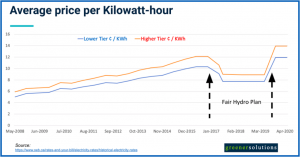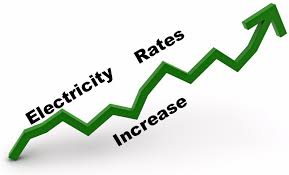 August 2020
August 2020
Toronto has had some of the highest electricity bill increases in North America over the past decade. Electricity prices, having risen more slowly for a short period, are now rising more dramatically.
Condominium corporations and building residents can expect annual increases in electricity fees. With electricity accounting for up to 40 percent of the budget, higher condo fees will be needed to pay these increases unless steps are taken to reduce overall energy consumption.
 Why electricity prices are on the rise
Why electricity prices are on the rise
Ontario began a concerted effort to eliminate use of coal for electricity generation in 2003. Coal, then and now the cheapest source of electricity, made up 25 percent of the province’s power generation. The goal was achieved in 2014 at which time our energy supply came from nuclear (60 percent), hydro (24 percent), gas (9 percent) and the remaining 7 percent from other sources.
Ontario has a more sustainable energy system without the pollution that comes from coal. The cost of this was a 51 percent increase in electricity prices from 2005 to 2014, and subsequent increases of 7 to 8 percent per year.
Toronto has benefited from eliminating use of coal. Brown outs and power failures are less common. Smog alerts and bad weather days, common in the past, are of less concern.
The costs of these benefits are paid by everyone that uses electricity – meaning everyone in Ontario – in what is called a Global Adjustment. The Global Adjustment is a fee on every electricity bill included in the per kilowatt hour charge. In 2015 it averaged 77 percent of the total electricity charge for residential customers and small businesses; 7.9 cents per kilowatt hour. It covers the cost of building, maintaining and upgrading our energy infrastructure plus conservation and demand management initiatives.
In 2017 the Global Adjustment was reduced by an average of 25 percent for residential customers. Rate increases were curtailed for four years. Savings will be repaid through higher costs starting in 2021.
Reducing energy consumption
Suite metering, or submetering, remains one of the most effective ways to reduce energy consumption. Metering measures amount used so residents only pay for their personal consumption. Those who choose to keep their suite warmer in winter, for example, pay more than those who keep the temperature lower. Those who invest in energy efficient lighting benefit from lower electricity costs.
Parity (www.paritygo.com) offers a more proactive approach using artificial intelligence technology to better control HVAC systems. The system “learns” energy use patterns of your building while the system brain automatically adjusts building heating and cooling systems in real-time. The Parity system looks at how much electricity, gas and water are being used. Systems adjust to use the minimum energy necessary to maintain resident comfort levels. Benefits include improved energy efficiency, fewer emissions and savings of up to 30 percent while improving overall comfort.
Save on Energy (www.saveonenergy.ca) offers incentives of up to 50 percent on energy saving projects.
Reduced electricity bills for the corporation can be reinvested into other energy efficiency initiatives further reducing electricity consumption. Savings in electricity consumption for a high-rise residential condo building can be as much as 40 percent. No other energy conservation program has been found to yield comparable savings.
Condominium communities have been reluctant to implement suite metering programs or undertake energy reduction projects, preferring to reduce electricity use by educating residents. Such programs are estimate to provide savings of two to three percent.
Find Vendors in these Related Categories
- Air Quality
- Building Sciences
- Cleaning & Janitorial Services
- Cleaning Services - Ducts
- Energy Services
- Energy Services - Efficiency
- Energy Services - Electricity
- Energy Services - Gas
- Energy Services - Water
- Engineering Services
- Environmental Consulting
- Home Services & Automation
- HVAC
- Lighting Services & Suppliers
- Mould Detection & Remediation
- Odour Control







